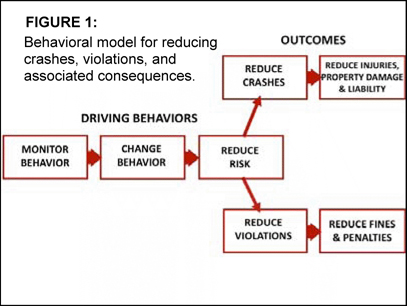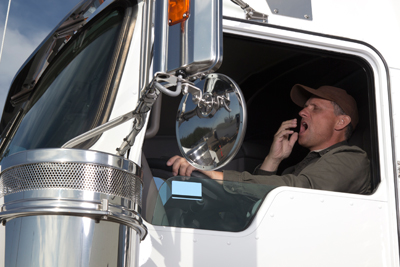Commercial Vehicle Safety: Onboard Safety Monitoring as Part of Behavioral Safety Management
Behavior-Based Safety (BBS) is the application of scientific behavior principles to modifying safety-related behaviors and reducing accidents and injuries. In the context of driving safety, this means changing drivers’ risky behaviors and styles, thereby reducing road risks, crashes, and traffic violations. In turn, this reduces injuries, property damage, liability, legal penalties, and financial loss. A simple behavioral model for the reduction of crashes and traffic violations is shown in Figure 1 below.
 Historically, BBS has been applied most widely in industrial settings such as factories and utilities. These are generally group settings where safety-critical behaviors can readily be defined, observed, and changed in ways which decrease risk and negative outcomes. Behavioral observations could be done frequently by co-workers. Feedback to workers could be frequent and often immediate. Factory workers, equipment operators, and maintenance personnel often worked in teams or at least in proximity to one another. Behavioral improvement in these settings was a group process involving the development of social norms around safe habits, and safety esprit-de-corps.
Historically, BBS has been applied most widely in industrial settings such as factories and utilities. These are generally group settings where safety-critical behaviors can readily be defined, observed, and changed in ways which decrease risk and negative outcomes. Behavioral observations could be done frequently by co-workers. Feedback to workers could be frequent and often immediate. Factory workers, equipment operators, and maintenance personnel often worked in teams or at least in proximity to one another. Behavioral improvement in these settings was a group process involving the development of social norms around safe habits, and safety esprit-de-corps.
More recently, BBS methodology has had to deal with increasingly lean-staffed production environments. In many modern factories, a handful of operators run the entire plant. The “lone worker” used to represent someone in the field; increasingly, that describes factory workers sitting alone in control rooms. Nevertheless, these workers can get together at pre-shift meetings or on breaks, so there may still be opportunities to observe each other and discuss safety concerns while they are working.
 The scientific basis and effectiveness of BBS are unquestionable. ADI has successfully deployed BBS programs across a variety of industries. These programs have increased safe habits and consistently reduced incident rates and severities. Yet BBS faces at least three challenges when applied to changing behavior and reducing crashes in commercial fleets:
The scientific basis and effectiveness of BBS are unquestionable. ADI has successfully deployed BBS programs across a variety of industries. These programs have increased safe habits and consistently reduced incident rates and severities. Yet BBS faces at least three challenges when applied to changing behavior and reducing crashes in commercial fleets:
- Observation difficulties. Since most commercial drivers operate solo, most of their driving behaviors are not directly observable by others. Some companies conduct random, secret surveillance of their drivers on the road, but this practice is often “hit or miss” and inefficient. Companies may place “How’s My Driving” placards on the backs of their trucks or trailers to solicit feedback from the public. Most such feedback is in the form of complaints, which may or may not be reliable or truly representative of a driver’s behavior. Another method is supervisor ride-alongs, which can help in driver evaluation and training. Ride-alongs can identify skill deficiencies and some bad habits, but a driver being observed is always on his or her best behavior. Drivers don’t reveal their true, over-the-road driving styles and behavioral choices when a supervisor is sitting beside them.
 Infrequency of crashes and violations. Crashes and traffic violations are rare outcomes, even for bad drivers. The average long-haul truck has a police-reported crash about once every seven years, and yet that crash can be a disaster, ruining lives and taking down a company. Traffic violations are also infrequent. Both crashes and violations are outcomes which reflect driver behavior but also “the luck of the draw.” Because they are infrequent and to some extent random, crashes and traffic violations are not ideal direct targets of BBS interventions.
Infrequency of crashes and violations. Crashes and traffic violations are rare outcomes, even for bad drivers. The average long-haul truck has a police-reported crash about once every seven years, and yet that crash can be a disaster, ruining lives and taking down a company. Traffic violations are also infrequent. Both crashes and violations are outcomes which reflect driver behavior but also “the luck of the draw.” Because they are infrequent and to some extent random, crashes and traffic violations are not ideal direct targets of BBS interventions.
- Feedback and consequences may be delayed, tied to outcomes rather than to behavior, and negative. Feedback is most powerful when it is frequent, reliably tied to specific behaviors, timely, constructive, and supportive. That’s generally not the case with the driving observation methods described above. It’s absolutely not the case with crashes and violations, where feedback is usually long delayed and always negative. A driver may be making mistakes and misbehaving for years before crashing or even receiving a ticket. An extended record of no crashes or violations is one basis for recognizing good drivers, but that is, by definition, long-delayed feedback. Plus, non-crash involvement is unreliably tied to behavior since luck plays a role. “Million-Mile Driver” or similar kudos are fine but they don’t get at the heart of behavior change for the majority of drivers.
Driver Behavior Monitoring Systems
Most of the above barriers disappear when one considers using in-vehicle technologies to observe driver behaviors. Onboard Safety Monitoring (OBSM) is continuous measurement and recording of safety-related driving behaviors like speed, acceleration, and braking force1. Potentially, OBSM can involve any safety-related driving parameter measurable in a vehicle. Vehicle speed and speed and hard braking applications are the most frequently measured parameters. Commercial OBSM devices like Tripmaster®, Qualcomm®, and Cadec Mobius TTS® provide these driver metrics. The Eaton VORAD® Forward Collision Warning (FCW) radar system provides warnings to a driver tailgating another vehicle or closing too rapidly. The system also records the number of driver warnings and the rapidity of closing events. Another device called the Roll Stability Advisor (RSA) records high lateral forces on curves which could result in a rollover. The RSA provides in-vehicle feedback to drivers and post-trip feedback to fleet managers.
Almost all advanced collision warning systems, including forward collision, lane departure, and lane change/merge warning systems can function as monitors as well. These systems are designed primarily to provide warnings to prevent imminent crashes, but they can also provide data and feedback to help prevent future crashes. For example, an FCW unit continuously tracks headway range and closing rates, and provides immediate in-vehicle feedback to the driver. It can also provide post-trip summary feedback to both the driver and the safety manager.
 Another emerging technology, not quite ready for prime time, is driver alertness monitoring. Systems are being developed and refined to measure driver status and performance to provide in-vehicle warnings and feedback to drowsy drivers. In this case, feedback facilitates performance by convincing drivers to stop for rest and, more importantly, change their lifestyle choices to get more sleep. Consider the safety value of the speedometer in your car or truck. Now imagine having an in-vehicle “alertometer” that can perform a similar function in relation to your driving alertness and performance. Wouldn’t that be a helpful aid to long-distance driving?
Another emerging technology, not quite ready for prime time, is driver alertness monitoring. Systems are being developed and refined to measure driver status and performance to provide in-vehicle warnings and feedback to drowsy drivers. In this case, feedback facilitates performance by convincing drivers to stop for rest and, more importantly, change their lifestyle choices to get more sleep. Consider the safety value of the speedometer in your car or truck. Now imagine having an in-vehicle “alertometer” that can perform a similar function in relation to your driving alertness and performance. Wouldn’t that be a helpful aid to long-distance driving?
Almost all truck and bus fleet managers regularly track their driver outcomes, including crashes, incidents, and violations. They consider such monitoring to be fundamental to sound safety management2. Yet, even though the technology is available, relatively few use OBSM to track the source safety behaviors that create these negative outcomes. Outcome tracking is necessary, but consider these OBSM advantages3
- OBSM documents specific driver behaviors causing crashes, incidents, and violations.
- Drivers can receive proactive corrective feedback before a crash, incident, or violation occurs.
- Evaluations and feedback are objective, timely, and frequent.
- Drivers can receive positive feedback and rewards for their successes.
- Driving behavior benchmarks can be set so drivers know where they stand in relation to carrier norms and expectations.
- Rewards and recognition can be individualized but also structured to reinforce group achievements, thereby fostering esprit-de-corps.
- OBSM can replace time-consuming ride-alongs, and it is more indicative of true behavior because no observer is present.
- OBSM can obtain a 100% sample of behavior
OBSM systems need to be configured and deployed
as part of a total behavioral management system.
When possible, systems should provide end-of-trip summary feedback so drivers can see where they stand. OBSM data should be an input to driver training and regular driver evaluations. Driver and group performance improvement goals should be specified using OBSM benchmarks.
As in all BBS, behaviors observed and recorded through OBSM should be reliably followed by consequences, and these consequences should be positive whenever possible. That is, new measurement technologies should highlight what people are doing correctly as well as pinpoint ways they can improve. Managers should look for ways to recognize and reward both individual driver improvements and group accomplishments. In this way, OBSM won’t be seen as a punishment tool but as a tool to help professionals become even better at their jobs.
Does One Type of Risky Behavior Indicate Others?
Currently, there are in-vehicle technologies to continuously measure a dozen or more safety-relevant driving behaviors. A few of these technologies were described above. What if your company can’t afford all these “bells and whistles,” or you just don’t have management resources to deal with all the possible metrics? What if you only monitor speed and hard braking, like most carriers currently using OBSM? Does that mean you are only getting a glimpse of drivers’ safety behaviors? Yes and no. Yes, your data is limited to these metrics, and you will not see other facets of safety behavior. But you are not just getting a glimpse. Drivers manifest their driving personalities, styles, and habits in many different ways. Individual differences in behavior are largely consistent across different situations, and that includes different elements of driving. Aggressive driving, for example, is usually apparent across multiple measures for a driver. Speed and hard braking are not the only dimensions of safe driving, but monitoring these does provide a general indication of a driver’s safety. One type of risky driver behavior does typically indicate that there are others.
You may be surprised to learn that driver fuel economy is an excellent index of safe driving. Fuel economy is a “driving style” measure which reflects a cluster of interrelated behaviors. These behaviors include speed selection, acceleration patterns, forward headway selection, and braking force. Fuel-efficient drivers are “smooth operators.” They glide through traffic, allow plenty of space around their vehicles, and avoid harsh maneuvers. They look ahead in the traffic stream to predict and react smoothly to changes and interruptions in traffic flow. This defensive, anticipatory driving style also reduces crash risk. A capability for onboard fuel consumption monitoring is commonplace in today’s trucks and buses. Electronically controlled engines can automatically monitor and display fuel consumption. Many Electronic Onboard Recorders (EOBRs) used to track driver Hours-of-Service can also monitor fuel consumption. If you can measure your drivers’ fuel efficiencies, you have OBSM and can use it as a basis for fleet safety improvement (and to save some money)!
Aids, Not Threats
The word "monitoring" in Onboard Safety Monitoring sounds ominous and threatening to many people. An obstacle to overcome in implementing OBSM is resistance from drivers who feel threatened by its use. In surveys, commercial drivers generally recogniz the potential safety value of OBSM. Yet, reflexively, most drivers they don't like invasions of their privacy or the implication that they are not trusted. To counter this understandable reaction, OBSM should be implemented in a positive and supportive management environment. Drivers may still be held accountable, but try to make them feel that they are being helped, not threatened. Tom Kretsinger, Jr., president of the truckload carrier American Central Transport, says the key to getting drivers to accept OBSM is to convince them that it's a tool rather than a sign of mistrust. "The more tools a driver has in his toolbox, the better he will become."
The best feedback
- Timely
- Objective
- Specific
- Individualized
- Constructive
- Supportive
OBSM feedback to drivers should be specific and individualized, but it should not be perceived as personally threatening. One way to achieve this balance is to provide direct, objective feedback to each driver, but to treat each driver’s data as confidential. Each driver will benefit from private, individual feedback. Separately, data can be pooled among multiple drivers (for example, drivers operating out of a particular company terminal) for “public” use, including group training, benchmarks, and rewards. Group goal-setting and celebrations of success can occur exactly as in conventional BBS. Thus the reinforcing social dynamics of BBS are brought into play along with each driver’s self-focused improvement efforts.
OBSM employs advanced in-vehicle technologies, but technology doesn’t change the fundamental tenets of behavioral safety management. In fact, the only key difference between BBS with and without OBSM is the observation method itself. All the other BBS elements are still the same. Reinforcement is still the key ingredient, and positive reinforcement is still the optimal choice for sustained behavior change and organizational improvement.
Editor’s Note: Dr. Ron Knipling is the author of Safety for the Long Haul; Large Truck Crash Risk, Causation, & Prevention. He is a researcher, consultant, and trainer with 30 years experience in large truck safety. Dr. Cloyd Hyten is Director of Safety Solutions for ADI. He joined the consulting world after an academic career that spanned 20 years of laboratory behavior research and applications in organizations designed to improve business performance.
1Knipling, R.R. Safety for the Long Haul; Large Truck Crash Risk, Causation, & Prevention. American Trucking Associations. ISBN 978-0-692-00073-1, 2009.
2Knipling, R.R., Hickman, J.S., and Bergoffen, G. Synthesis 1: Effective Commercial Truck and Bus Safety Management Techniques; A Synthesis of Safety Practice. TRB Commercial Truck & Bus Synthesis Program Project, ISSN 1544-6808, ISBN 0-309-08754-6, 2003.
3Knipling, R.R. Safety for the Long Haul; Large Truck Crash Risk, Causation, & Prevention. American Trucking Associations. ISBN 978-0-692-00073-1, 2009.
4Roetting, M., Huang, Y-H., McDevitt, J.R., and Melton, D. When technology tells you how to drive – truck drivers’ attitudes toward feedback by technology. Transportation Research Part F, Elsevier Publishing, pp. 275-287, 2003.
5Transport Topics interview, May 14, 2007.


